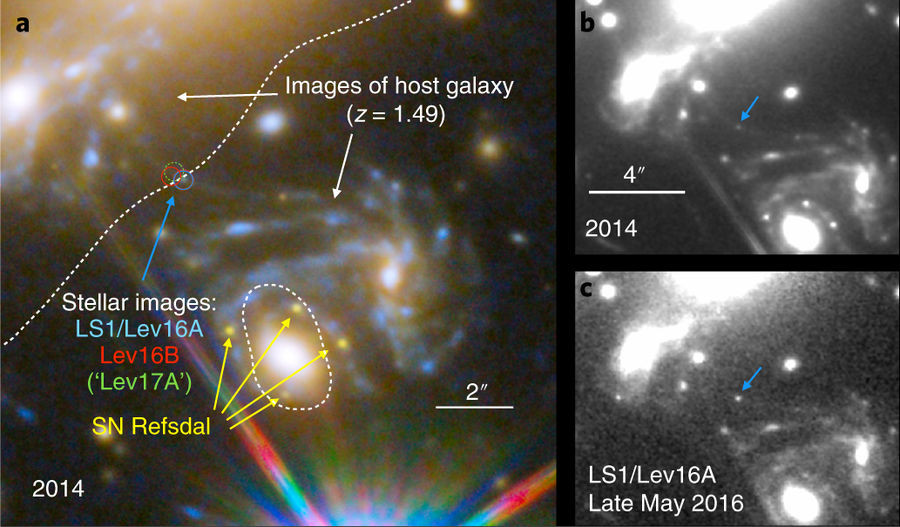銀河団の重力レンズによる赤方偏移1.5にある単独の恒星の極度な増光
Extreme magnification of an individual star at redshift 1.5 by a galaxy-cluster lens
2018年4月2日 Nature Astronomy 2 : 334 doi: 10.1038/s41550-018-0430-3

銀河団による重力レンズ効果は、背景にある銀河を全体でおよそ50倍まで増光できる。本論文では、2,000倍以上に増光された、赤方偏移z=1.49に位置する単独の恒星(MACS J1149 Lensed Star 1と名付けた)の像について報告する。分離した像が、Lensed Star 1からわずか0.26秒離れたところに発見され、これは銀河団中にある太陽質量の3倍以上の天体のはたらきによる、おそらく複数年にわたって縮小された第1の星の逆像である。レンズ効果を生じる系についての合理的な仮定のもとで、恒星の光度曲線における重力マイクロレンズ効果による変動からは、連星系の割合や特定の恒星進化、それに超新星モデルを含め、銀河団内の恒星や高密度天体の質量関数についての証拠を得ることができる。暗黒物質のサブハローあるいは大質量の高密度天体が、2つの像の長期間に及ぶ光度比を説明できる可能性がある。
Corresponding Author
Galaxy-cluster gravitational lenses can magnify background galaxies by a total factor of up to ~50. Here we report an image of an individual star at redshift z = 1.49 (dubbed MACS J1149 Lensed Star 1) magnified by more than ×2,000. A separate image, detected briefly 0.26″ from Lensed Star 1, is probably a counterimage of the first star demagnified for multiple years by an object of ≳3 solar masses in the cluster. For reasonable assumptions about the lensing system, microlensing fluctuations in the stars’ light curves can yield evidence about the mass function of intracluster stars and compact objects, including binary fractions and specific stellar evolution and supernova models. Dark-matter subhaloes or massive compact objects may help to account for the two images’ long-term brightness ratio.

